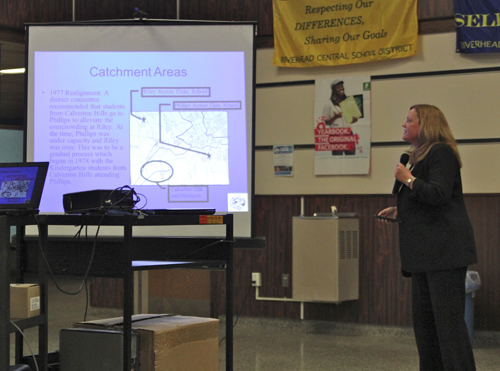Riverhead BOE mulling study to redraw elementary school lines

In response to recent concerns from parents voiced at school board meetings about the demographic makeup of the district’s elementary schools, the Riverhead School District is now considering a study to determine if reconfiguring boundaries for its five elementary schools is needed.
During the school board’s meeting Tuesday, Superintendent Nancy Carney said Eastern Suffolk BOCES offers a nearly $9,000 service to analyze demographics, real estate trends and enrollment projections that could provide the district with “data-based recommendations” on changes to the current boundaries — known as catchment areas — for Riley, Phillips, Aquebogue, Roanoke and Pulaski elementary schools.
The last redistricting took place in 2002, she said, in order to equalize enrollment after additional classroom space was constructed at Aquebogue, Phillips and Riley buildings. Those schools went from K-3 to K-4 buildings, Pulaski went from 4-5 to a 5-6 building, and the middle school went from 6-8 to a 7-8 building, she said.
Ms. Carney also outlined elementary school enrollment between the 2010-11 and 2013-14 school years. During that four-year time period, Phillips became the most populated school, with an increase of 70 students for a total of 582 students. Riley experienced the largest decrease over that time frame, she said, with 40 students less, totaling 580.
Aquebogue’s enrollment declined by 21 students, for a total of 469 students. Roanoke’s enrollment increased by 53 students, for a total of 410 students, according to the superintendent’s presentation.
The last redistricting also involved having students living at the apartment complex across from Peconic Bay Medical Center attend school at Riley instead of nearby Roanoke. Students at the Doctors Path apartments were shifted from Roanoke to Aquebogue.
Ms. Carney also provided demographic information about elementary school student enrollment:
• Riley: 72 percent of students are white, 5.5 percent black and 17.3 percent Hispanic.
• Phillips: 61 percent of students are Hispanic, 19.5 percent is black and 15.9 percent is white.
• Aquebogue: 50.1 percent of students are white, 33.3 percent Hispanic and 14.3 percent black.
• Pulaski: 52.9 percent of students are white, 27 percent is Hispanic and 16.8 percent is black
• Roanoke: 56.7 percent of students are Hispanic, 27.6 percent white and 10.9 percent black.
Over at the high school, there are 1,528 students, with 51.6 percent white, 28.3 percent Hispanic and 17.1 percent black. The middle school’s 724 student population is 51.8 percent white, 28.3 percent Hispanic and 17.3 percent black.
There are a total of 67 Asian students, which represents 1.3 percent of the district’s total student population, and there are 23 American Indian or Alaskan native students.
Ms. Carney has said she believes this is the first time the majority of Riverhead’s students are minorities, which currently makes up about 52 percent of the district’s total population of 5,041.
As for concerns about elementary school boundaries, residents have been questioning at recent school board meetings why students living in Calverton Hills are required to enroll at Phillips in Riverside when Riley in Calverton is closer to them.
Ms. Carney said the decision to shift Calverton Hills students from Riley Avenue to Phillips Avenue was made in 1977 due to overcrowding at Riley. The shift took effect the following school year, she said.
The elementary school boundaries for Calverton Hills sparked after an incident reported in a Feb. 27 News-Review cover story about two Riley Avenue students who brought a knife to school and plotted an attack on a fellow second-grader in November. The victim’s mother, who is black, said in the article she was concerned that race had played a role in permitting those students, who are white, to return to class just three months after the incident, despite a code of conduct that suggests a minimum one-year suspension for incidents involving a weapon.
During the public comment portion of Tuesday’s meeting, Riverside resident Bob Brown called on the school board and concerned residents to come up with solutions to improve relationships within the community.
“The view that I think the community has of Riley Avenue has been changed — It has a view that is racist,” he said. “I think [the victim’s mother] wasn’t treated as an equal parent with the incident with her son.
“It’s not just Riley Avenue — it’s a Riverhead thing,” he added. “There has to be changes in Riverhead.”


